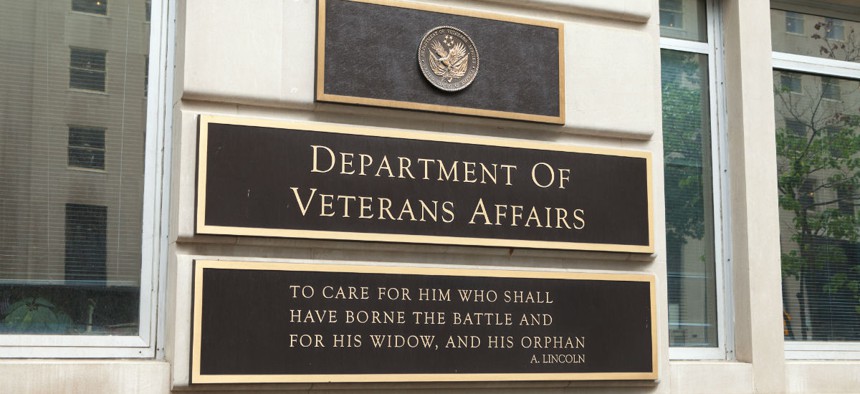
Mark Van Scyoc / Shutterstock.com
VA Faces Multi-Faceted Challenges to Its Attempts at Firing and Accountability Reform
The department can no longer publicly post its disciplinary data.
The Veterans Affairs Department can no longer publish the data related to its disciplinary actions against employees, a third-party arbitrator has ruled after a challenge from VA’s largest union.
The ruling, issued earlier this year, was a blow to a department claiming unprecedented transparency and accountability after years of negative attention. It began in 2017 publishing a list of its adverse actions taken against employees, the first federal agency to do so.
“Under this administration, VA is committed to becoming the most transparent organization in government,” then-VA Secretary David Shulkin said when announcing the disclosures. “Together with the accountability bill the president signed into law recently, this additional step will continue to shine a light on the actions we’re taking to reform the culture at VA.”
The American Federation of Government Employees quickly challenged the decision, resulting in arbitration through the Federal Mediation and Conciliation Service. Andrew Strongin, the arbitrator, said there was no dispute that Shulkin made the decision of his own accord, to “redress a major problem with public credibility” and “rehabilitate the agency’s public image” following the wait time scandal from 2014 and that VA has published the information without consent of the disciplined employees.
Phillip Works, senior adviser at the Office of Accountability and Whistleblower Protection, which is responsible for publishing the information, acknowledged the list has created privacy concerns and negatively impacted employee morale.
While individuals’ names have been scrubbed from the public-facing list, the arbitrator found employees within the department could at times discern specific names from the available information.
“Efforts to scrub and sanitize records, however laudable, are not a sufficient defense to prove that, despite those efforts, the agency’s publication nevertheless permitted those with no right to know specifically to identify particular disciplined employees,” said Strongin, who ruled that VA violated both the Privacy Act and provisions of its collective bargaining agreement with AFGE.
The arbitrator also said VA committed an unfair labor practice by denying AFGE the right to bargain over the publishing of the disciplinary list. He directed VA to remove the list from its website and to cease publishing it until it can produce it without violating the Privacy Act. Because VA knowingly violated the law, the arbitrator said, VA must reimburse AFGE for its attorney fees.
Curt Cashour, a VA spokesman, said the department is disappointed by the decision, but is working on a revised format to publish the disciplinary data.
“This ruling is an affront to government transparency and VA is reworking the reports to be able to convey information to enhance transparency to the greatest extent without violating the arbitrator’s order,” Cashour said. For now, he added, “VA must comply with AFGE’s demand to keep the department’s accountability actions shrouded in secrecy.”
The temporary lack of public data is a second blow to VA’s attempt at renewed accountability in recent months. In May, the department said it would no longer defend in court its new law allowing expedited firing against a challenge from an employee at the center of perhaps the most public disciplinary action taken since its passage.
Brian Hawkins, the former director of the Washington, D.C., Medical Center, challenged his firing under the 2017 VA Accountability and Whistleblower Protection Act as both arbitrary and capricious as well as unconstitutional. The law became effective after an initial disciplinary action against Hawkins, but Shulkin moved to re-fire him under its revised provisions.
“This is the right decision for veterans in D.C., and employees at the medical center, and underscores our commitment to hold employees accountable if they fail to do their jobs or live up to VA’s values,” Shulkin said in 2017.
Before a federal judge could rule on the matter, VA told the court it decided to reinstate Hawkins with back pay. The department’s decision could have far reaching impact, but the case is now indefinitely stayed so VA will, for the time being, avoid a potentially precedent-setting ruling. The department still faces multiple challenges to the law’s constitutionality in various federal courts.
VA’s problems are not just confined to firing employees. It is also struggling to hire new staff to keep pace with its needs. The department’s vacancies eclipsed 50,000 as of the end of March, according to recently released data, a 2.5% increase over the previous quarter of the fiscal year. VA saw 20,000 accessions (which includes both new hires and transfer-ins) compared to 16,000 separations, but the department still failed to keep pace with attrition and a growing number of authorized positions.
VA has defended itself by noting its turnover rate is actually better than that seen in private health care networks and that the large number of vacancies obscures positive health outcomes and improving wait times for veterans.







